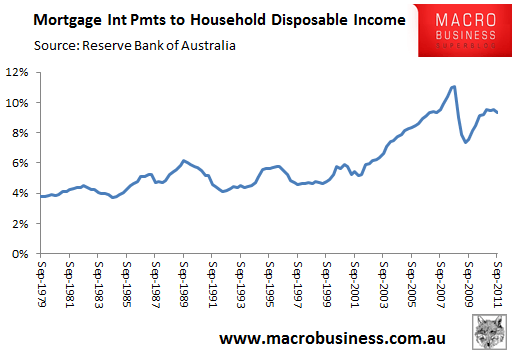In Canada and Australia the bulls have argued that expensive houses are still as affordable as ever because of low interest rates. (Ignoring that those rates aren't fixed for long, but that's a separate issue.)
This chart from today's Macrobusiness Blog demonstrates that credit has been issued in excess of the monthly nut affordability measures. Interest payments on mortgages as a fraction of disposable income has been on a steady rise since 2000. The GFC really threw a monkey wrench into what appears to have been non-linear growth in interest relative to disposable income. Goes to show that a system where a lot of people make money on the status quo will not get fixed or addressed without a shock to it.
I'll take a look around, see if I can find similar data for Canada.
Welcome Back Kohler
This chart from today's Macrobusiness Blog demonstrates that credit has been issued in excess of the monthly nut affordability measures. Interest payments on mortgages as a fraction of disposable income has been on a steady rise since 2000. The GFC really threw a monkey wrench into what appears to have been non-linear growth in interest relative to disposable income. Goes to show that a system where a lot of people make money on the status quo will not get fixed or addressed without a shock to it.
I'll take a look around, see if I can find similar data for Canada.
Welcome Back Kohler

2 comments:
More home owners with mortgages - or did they adjust for that?
I thought it was total mortgage interest paid by everyone mortgage divided by total disposable income of everyone with a mortgage. Unless they computed it with total mortgage interest paid by everyone (with a mortgage or not) divided by total disposable income. ...
Well, it is true that far more households have mortgages:
"Around 37 per cent of Australian households had owner-occupier mortgage debt in 2009, up from 31 per cent in 2001. This debt was largely concentrated in households in the top two income quintiles (those with annual after-tax household income of $77,500 or more), with these households holding around 70 per cent of mortgage debt in 2009."
http://www.rba.gov.au/publications/fsr/2011/mar/html/box-c.html
I don't have an answer, since I didn't make the graph. I did leap to the conclusion that it was adjusted and that was a mistake.
Post a Comment